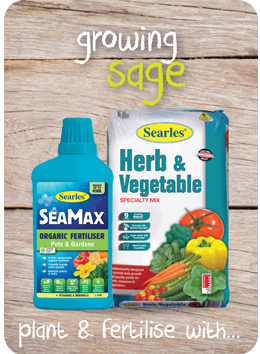Growing and Planting Sage
 |
|
Sage (Salvia officinalis) is a very practical herb to complement herb or vegetable gardens. Its silvery-grey leaves emit a generous amount of aroma and flavour enhancing the tastiness of meat dishes, stuffing for chicken and adds the perfect finish to potato dishes. Sage has been used for centuries as a healing herb, touting antiseptic and antifungal properties. Their purple, sometimes white or pink, flowers, attract bees and beneficial insects into the garden making it perfect for companion planting.
Planting SageLike many other Mediterranean herbs, sage prefers full sun, warm days and dry summers. They don’t like humid weather and wet feet. They are considered a hardy herb, flourishing in well-drained soil with open-air circulation. Sage favour being planted in pots, as potting mix properties aid excellent drainage. Many gardeners use sage as a companion plant, using them as borders to their vegetable garden to ward off pests.
Sage can be planted any time of year in all Australian climatic zones. Even though Sage is fairly frost tolerant, protect from extreme frosts by moving to a more protected area. If your sage is planted in the garden and touched up by frosts it will quickly bounce back as the warmer weather arrives.
Plant sage in Searles Herb & Vegetable Specialty Mix for potted displays or mix 5 IN 1 Organic Fertiliser to enrich the soil for garden beds.
Fertilising & Watering SageIf the soil is enriched with plenty of compost before planting, you shouldn’t need to fertilise too often. To top up nutrients liquid fertilise with Searles Organic Fertiliser Liquid every couple of months.
Pest & Diseases of SageThey aren’t too many problems affecting sage. Keep an eye out for caterpillars, mealybugs and powdery mildew. If you keep the soil on the drier side and maintain open airflow around the bush you shouldn’t have to worry.
Other popular edible varieties of sagePineapple sage (S. elegans) - As the names implies has a strong pineapple flavour. The leaves and red flowers can be eaten.
Fruit Sage (S. dorisiana) - Magenta pink flowers appear in Winter. Their leaves emit a 'fruit salad' aroma, wonderful for tea making.
Companion plantingPlant sage with beans, carrots, cucumber, rosemary and strawberries. |
--------------------------------- |





